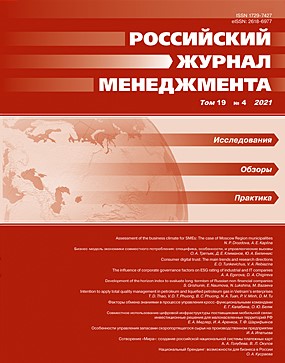Factors of knowledge sharing in cross-functional teams
DOI:
https://doi.org/10.21638/spbu18.2021.407Abstract
The article is devoted to study the factors of knowledge sharing in managing the cross-functional teams of Russian companies within innovative development. The goal of the paper was to analyze the influence of individual, organizational, and managerial factors on the activity of cross-functional team members in knowledge sharing. Based on the results of the survey among 259 participants of cross-functional teams, the econometric assessment was done to determine that intrinsic motivation as an individual factor makes sense asa moderator for exolaining the relationship between organizational, managerial factors and activity of participants in knowledge sharing. As a result of the analysis of the management factorsthe most favorable mechanism of coordination for knowledge exchange was mutual coordination. It was implemented through informal communication and it was based on understanding of roles, degree of responsibility and sense of belonging by the team members. It was also revealed that organizational factors, including the system of incentives, have little influence on the activity of participants in knowledge sharing. The findings can be the basis for appropriate choosing the cross-functional team management tools for innovative development.
Keywords:
cross-functional teams, knowledge sharing, coordination mechanisms, intrinsic motivation
Downloads
References
Nonaka I. (1994). A dynamic theory of organizational knowledge crea-tion. Organization Science, 5 (1), 14-37.
Abdi K., Mardani A., Senin A.A., Tupenaite L., Naimaviciene J., Ka-napeckiene L., & Kutut V. (2018). The effect of knowledge manage-ment, organizational culture, and organizational learning on innova-tion in the automotive industry. Journal of Business Economics and Management, 19, 1, 1-19. https://doi.org/10.3846/jbem.2018.1477.
Kalabina, E. G., & Belyak, O. Yu. (2019). Creation of CFTs of parallel design for the development of new products. Kadrovik, 3, 62–68.
Nestik T.A. (2014). Knowledge management models in Russian organi-zations: a socio-psychological analysis. Modern management technol-ogies, 1 (37), retrieved October 9, 2021, from https://sovman.ru/article/3705/
Hsiao R.-L., Tsai S. D.-H., & Lee C.-F. (2006). The problems of embed-dedness: Knowledge transfer, coordination and reuse in information systems. Organization Studies, 27 (9), 1289–1317.
Kalabina E.G., & Belyak O. Yu. (2020). CFTs as a tool for developing the company's knowledge potential. Bulletin of St. Petersburg Univer-sity. Management, 19 (3), 336–361. http://doi.org/10.21638/11701/spbu08.2020.303
Chen L., & Wang J. (2020). Study of Its Complexity and Evaluation on Knowledge Synergy Effect in Cross-functional Expert Team. Associa-tion for Computing Machinery, https://doi.org/10.1145/3453187.3453324
Kwan L.B. (2019) The collaboration blind spot. Harvard Business Re-view, 97, 2, 66-73.
Bagrationi K.A., & Nestik T.A. (2018). Viability of small groups in or-ganizations: state and research prospects. Organizational Psychology, 8, 4, 75–94
Foss N. J. (2007). The emerging knowledge governance approach: Challenges and characteristics. Organization, 14 (1), 29–52.
Young-Hyman T. (2017). Cooperating without Co-laboring: How For-mal Organizational Power Moderates Cross-functional Interaction in Project Teams. Administrative Science Quarterly, 62 (1), 179-214. doi:10.1177/0001839216655090
Le Meunier-FitzHugh K., & Massey G. (2019). Improving relationships between sales and marketing: the relative effectiveness of cross-functional coordination mechanisms. Journal of Marketing Manage-ment, 35, 1-24. DOI: 10.1080/0267257X.2019.1648310.
Milner B.Z. (2012). Organization theory. Мoscow: INFRA-M.
Willem A., & Buelens, M. (2007). Knowledge sharing in public sector organizations: The effect of organizational characteristics on interde-partmental knowledge sharing. Journal of Public Administration Re-search & Theory, 17(4), 581-606.
Mintzberg G. (2004). Structure in a fist: building an effective organi-zation. St. Petersburg: Piter
Baker W., & Sinkula, J. (1999). The synergistic effect of market orien-tation and learning orientation on organizational performance. Journal of the Academy of Marketing Science, 27 (4), 411-427.
Edmondson A. (1999). Psychological safety and learning behavior in work teams. Administrative Science Quarterly, 44 (2), 350–383.
Morgan P., Fletcher D., Sarkar M. (2015). Understanding team resili-ence in the world's best athletes: a case study of a rugby union World Cup winning team. Psychology of Sport and Exercise, 1, 91–100.
Waris M., Khan A., Ismail I., Adeleke A. Q., & Panigrahi S. (2017). Im-pact of leadership qualities on employee commitment in multi-project-based organizations. IOP. https://doi.org/10.1088/1755-1315/140/1/012094
Mubarak F., & Noor A. (2018). Effect of authentic leadership on em-ployee creativity in project-based organizations with the mediating roles of work engagement and psychological empowerment. Cogent Business & Management, 65 (1), 1-14. http://doi.org/10.1080/23311975.2018.1429348
Alrawi Kh., Hamdan Y., Al-Taie W., & Ibrahim M. (2011). Organiza-tional culture and the creation of a dynamic environment for knowledge sharing. American Journal of Social and Management Sci-ences, 2.3, 258-264.
Hsu C., & Lin J. (2008). Acceptance of blog usage: The roles of tech-nology acceptance, social influence and knowledge sharing motiva-tion. Information & Management, 45(1), 65–74.
Perez M., Cruz V., Cruz M., Celina N., & Celina C. (2009). The influ-ence of internal and extrinsic motivation on knowledge transfer. The case of a nonprofit organization. Retrieved October 9, 2021, from https://www.researchgate.net/publication/281861234_The_influence_of_internal_and_extrinsic_motivation_on_knowledge_transfer_The_case_of_a_nonprofit_organization
Javernick-Will A. (2012). Motivating knowledge sharing in Engineer-ing and Construction Organizations: Power of Social Motivations. Journal of Management in Engineering, 28, 193-202. DOI: 10.1061/(ASCE)ME.1943-5479.0000076.
Slater S.F., & Narver J. С. (1995). Market orientation and the learning organization. Journal of Marketing, 59, 3, 63-74.
Wu W.-L., Hsu B.-F., & Yeh R.-S. (2007). Fostering the determinants of knowledge transfer: A team-level analysis. Journal of Information Science, 33 (3), 326–339.
Sergeeva A.V., Andreeva T.A. (2014). How do management practices affect the knowledge sharing between employees? Research results in secondary schools. Russian Management Journal, 12, 2, 67-98.
Hair J. F., Ringle C. M., & Sarstedt M. (2011). PLS-SEM: Indeed a sil-ver bullet. Journal of Marketing Theory and Practice, 19 (2), 139–152.
Bagozzi R. P., Yi Y., & Phillips L. W. (1991). Assessing construct va-lidity in organizational research. Administrative Science Quarterly, 36 (3), 421–458.
Yasir M., Majid A. (2017). Relationship between determinants of or-ganizational structure and knowledge sharing. International Journal of Business Excellence, 12 (3), pp. 294-307. DOI: 10.1504/IJBEX.2017.084439
Mascia D., Pallotti F., Dandi R. (2018). Determinants of knowledge-sharing networks in primary care. Health Care Management Review, 43 (2), pp. 104-114. DOI: 10.1097/HMR.0000000000000139
Downloads
Published
How to Cite
Issue
Section
License
Articles of the Russian Management Journal are open access distributed under the terms of the License Agreement with Saint Petersburg State University, which permits to the authors unrestricted distribution and self-archiving free of charge.





